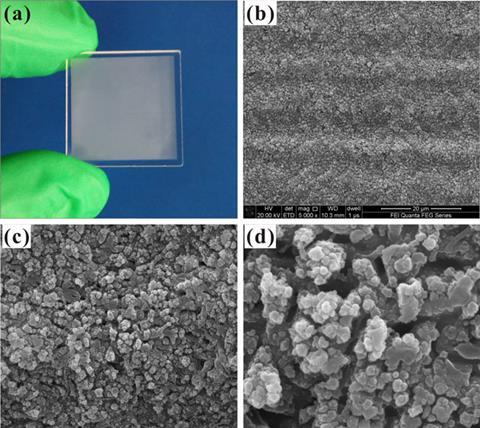Transparent surfaces for repelling oil underwater made from silica
Researchers in China have taken inspiration from fish scales and skeleton flowers to make a transparent underwater surface that stays clean by repelling oil.

Light scattering means that many synthetic oil-repellent surfaces are opaque, limiting their use. A transparent, oil-repellent surface would have applications in biology and underwater optics, including in diving goggles and cameras. Now, Feng Chen’s research group at Xi’an Jiaotong University has developed such a material.
Fish repel oil by trapping water within their scales to create a self-cleaning, oil-repellent coat and prompted part of the idea behind the work. Chen’s other brainwave was triggered by Diphylleia grayi – also known as the skeleton flower.

In air Diphylleia grayi’s petals appear white, but on contact with water they become transparent. This change is not due to a pigment but loose cell structure in the plant petals. On sunny days the air–liquid interface of the petals causes diffuse reflectance, endowing the petals with a white colour, whilst on rainy days water enters the petals, yielding a water–water interface, increasing light transmission so they turn transparent.
By using femtosecond laser ablation to create rough nanostructures on a silica glass surface, Chen and his team have made a surface that combines both of these systems – it turns transparent and repels oil when in water. Chen’s student, Jiale Yong, highlights the value of ‘realising the importance of having a trapped water layer’ as they hope to ‘apply the transparent oil-repellent material in underwater oil-repellent optical devices’.

Nanophotonics researcher, Hewei Liu from the University of Wisconsin-Madison, US, is impressed by the bio-inspired method referring to it as a smart idea. ‘The transparent oil-repellent surface provides researchers more choice to design and fabricate novel underwater optical devices,’ he adds. And Xu Deng, who specialises in innovative bio-inspired materials at the Lawrence Berkeley National Lab, US, says the work is an ‘important step towards finding an easy and reliable way to make oil-repellent materials’.
References
This article is free until 22 May 2015. Download it here:
J Yong et al, J. Mater. Chem. A, 2015, DOI: 10.1039/c5ta01104c












No comments yet